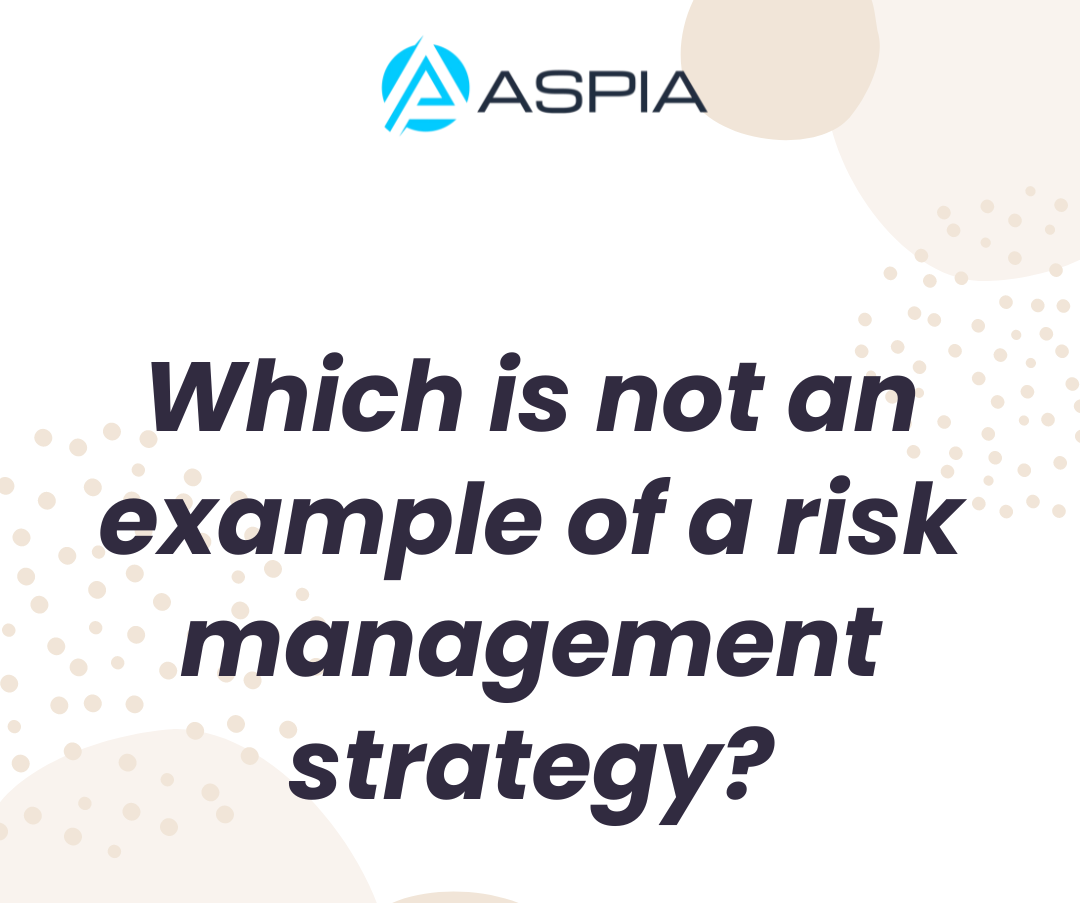In today’s volatile business landscape, risk management stands as a critical function for organizations aiming to mitigate potential threats and capitalize on opportunities. However, the realm of risk management is rife with complexities, from understanding effective strategies to debunking prevalent misconceptions.
Additionally, the advent of innovative software tools like ASPIA has revolutionized the risk management landscape, offering streamlined processes and enhanced capabilities. Let’s know each aspect to gain a comprehensive understanding of what is not an example of a risk management strategy.
Understanding Risk Management
Effective risk management involves a step by step approach to identify, assess, and mitigate potential risks that could impact an organization’s objectives. Key risk management strategies include:
- Risk Identification: This foundational step involves systematically identifying potential risks that could impact an organization’s objectives. From financial risks such as market volatility to operational risks like supply chain disruptions, a comprehensive approach to risk identification is crucial for anticipating and preparing for potential threats.
- Risk Assessment: Once risks are identified, organizations must assess their likelihood and potential impact to prioritize them effectively. This involves quantitative and qualitative analysis to determine the severity of each risk and its potential for the organization’s goals and objectives.
- Risk Mitigation: With risks prioritized, organizations can develop and implement mitigation plans to reduce or eliminate their impact. Risk mitigation strategies may include risk avoidance (e.g., exiting high-risk markets), risk transfer (e.g., purchasing insurance), risk reduction (e.g., implementing internal controls), and risk acceptance (e.g., acknowledging certain risks as unavoidable).
Which is not an example of a risk management strategy?
Despite the importance of risk management, several misconceptions persist:
- Ignoring Risk: Contrary to popular belief, ignoring risk altogether is not a viable strategy. While there are risks that will be unavoidable, acknowledging and addressing them is very essential for minimizing their future impact on the organization.
- Trusting in Luck: Relying solely on luck or fate to navigate risks is akin to gambling with the organization’s future. While luck may play a role in certain outcomes, effective risk management requires a systematic and active approach to identify, assess, and mitigate potential threats.
- Overreliance on Hope: Merely hoping for the best without concrete risk management strategies in place is a recipe for disaster. Effective risk management involves taking sound steps to address potential threats and capitalize on opportunities.
- Reactive Firefighting: Waiting until risks materialize before taking action is a reactive approach that can lead to costly consequences. A proactive risk management strategy involves anticipating potential risks and developing mitigation plans in advance to minimize their impact.
Additional Considerations in Risk Management Strategy
Ongoing Monitoring and Review
Effective risk management is not a one-time task but rather an ongoing process that requires constant vigilance and adaptation. Organizations must establish mechanisms for monitoring and reviewing their risk management practices to ensure they remain effective in the face of evolving threats and changing business environments.
Regular audits, performance evaluations, and risk assessments are essential for identifying new risks, evaluating the effectiveness of mitigation measures, and making necessary adjustments to the risk management strategy.
Moreover, technology-driven solutions like ASPIA can play a crucial role in facilitating continuous monitoring and review by providing real-time data analytics, automated alerts, and customizable reporting capabilities. By leveraging these tools, organizations can stay ahead of emerging risks and make informed decisions to protect their interests proactively.
Communication and Collaboration
Another vital aspect of effective risk management strategy is fostering a culture of communication and collaboration within the organization. Risk management is not the sole responsibility of a single department or individual but rather a collective effort that requires input and participation from stakeholders across the organization.
Open communication channels, regular meetings, and collaborative workshops can facilitate the sharing of information, insights, and perspectives on potential risks and mitigation strategies.
Furthermore, effective communication with external stakeholders, such as suppliers, partners, regulators, and customers, is essential for gaining a comprehensive understanding of the broader risk landscape and coordinating efforts to address shared risks collaboratively.
By fostering a culture of transparency, trust, and collaboration, organizations can enhance their ability to identify, assess, and mitigate risks effectively, ultimately strengthening their resilience and competitive advantage in the marketplace.
Software Tools for Risk Management: Introducing ASPIA
ASPIA stands out as an innovative automated platform for risk management. This software tool offers:
- Automated Risk Identification: ASPIA utilizes advanced algorithms to identify potential risks across various domains, enhancing the efficiency of risk identification processes.
- Dynamic Risk Assessment: With ASPIA, organizations can assess risks dynamically, considering factors such as severity, likelihood, and potential impact in real-time.
- Tailored Risk Mitigation Plans: ASPIA generates personalized risk mitigation plans based on identified risks, offering powerful insights to address vulnerabilities effectively.
- Streamlined Risk Monitoring: ASPIA provides real-time monitoring capabilities, enabling organizations to track risk indicators and adjust mitigation strategies accordingly.
Conclusion: Leveraging ASPIA for Comprehensive Risk Management
In conclusion, understanding effective risk management strategies, debunking common misconceptions, and leveraging advanced software tools like ASPIA are essential components of navigating the complexities of risk management in today’s business environment.
By adopting the right approach to risk management and harnessing the capabilities of innovative technologies, organizations can enhance their resilience, protect their interests, and achieve long-term success in the reign of uncertainty.





